seats LINCOLN MKZ 2013 Owners Manual
[x] Cancel search | Manufacturer: LINCOLN, Model Year: 2013, Model line: MKZ, Model: LINCOLN MKZ 2013Pages: 474, PDF Size: 3.79 MB
Page 4 of 474

Introduction
About This Manual..................................7
Symbols Glossary
....................................7
Data Recording........................................9
California Proposition 65
.....................11
Perchlorate...............................................12
Lincoln Credit
...........................................12
Replacement Parts Recommendation..............................12
Special Notices
.......................................13
Mobile Communications Equipment............................................13
Export Unique Options........................14
Child Safety
General Information.............................15
Child Seat Positioning
..........................17
Booster Seats
..........................................18
Installing Child Seats
............................21
Child Safety Locks................................29
Safety Belts
Principle of Operation..........................31
Fastening the Safety Belts................32
Safety Belt Height Adjustment.......36
Safety Belt Warning Lamp and Indicator Chime.................................37
Safety Belt Minder
................................38
Child Restraint and Safety Belt Maintenance......................................40
Personal Safety System ™
Personal Safety System ™
.................41Supplementary Restraints
System
Principle of Operation
.........................42
Driver and Passenger Airbags..........44
Knee Airbag............................................45
Front Passenger Sensing System..................................................45
Side Airbags
...........................................48
Side Curtain Airbags
............................49
Crash Sensors and Airbag Indicator................................................51
Airbag Disposal
......................................52
Keys and Remote Controls
General Information on Radio Frequencies........................................53
Remote Control
.....................................54
Replacing a Lost Key or Remote Control
..................................................57
MyKey®
Principle of Operation.........................58
Creating a MyKey..................................59
Clearing All MyKeys.............................59
Checking MyKey System Status...................................................60
Using MyKey With Remote Start Systems
...............................................60
MyKey Troubleshooting
.......................61
Locks
Locking and Unlocking.......................62
Keyless Entry..........................................68
Interior Luggage Compartment Release
.................................................70
1
Table of Contents
Page 5 of 474

Security
Passive Anti-Theft System................72
Anti-Theft Alarm
...................................73
Steering Wheel
Adjusting the Steering Wheel...........75
Audio Control
.........................................76
Voice Control
...........................................77
Cruise Control
.........................................77
Information Display Control..............77
Heated Steering Wheel......................78
Wipers and Washers
Windshield Wipers
...............................79
Autowipers..............................................79
Windshield Washers
...........................80
Lighting
Lighting Control
.....................................82
Autolamps...............................................82
Instrument Lighting Dimmer............83
Headlamp Exit Delay...........................83
Daytime Running Lamps...................83
Automatic High Beam Control
........84
Direction Indicators
..............................85
Interior Lamps
........................................85
Windows and Mirrors
Power Windows
....................................87
Global Opening and Closing............88
Exterior Mirrors......................................88
Interior Mirror
.........................................90
Sun Visors
...............................................90
Sun Shades
..............................................91 Moonroof..................................................91
Instrument Cluster
Gauges......................................................94
Warning Lamps and Indicators.......95
Audible Warnings and
Indicators.............................................99
Information Displays
General Information
..........................100
Information Messages
......................105
Audio System
General Information
...........................122
Audio unit - Vehicles With: Premium AM/FM/CD
........................................123
Media Hub
..............................................125
Climate Control
Automatic Climate Control.............126
Hints on Controlling the Interior Climate................................................127
Heated Windows and Mirrors.........128
Cabin Air Filter
......................................129
Remote Start
........................................129
Seats
Sitting in the Correct Position
..........131
Head Restraints
....................................131
Power Seats
..........................................133
Memory Function................................135
Rear Seats..............................................137
Heated Seats
.........................................137
Ventilated Seats
..................................139
Rear Seat Armrest
..............................140
2
Table of Contents
Page 8 of 474
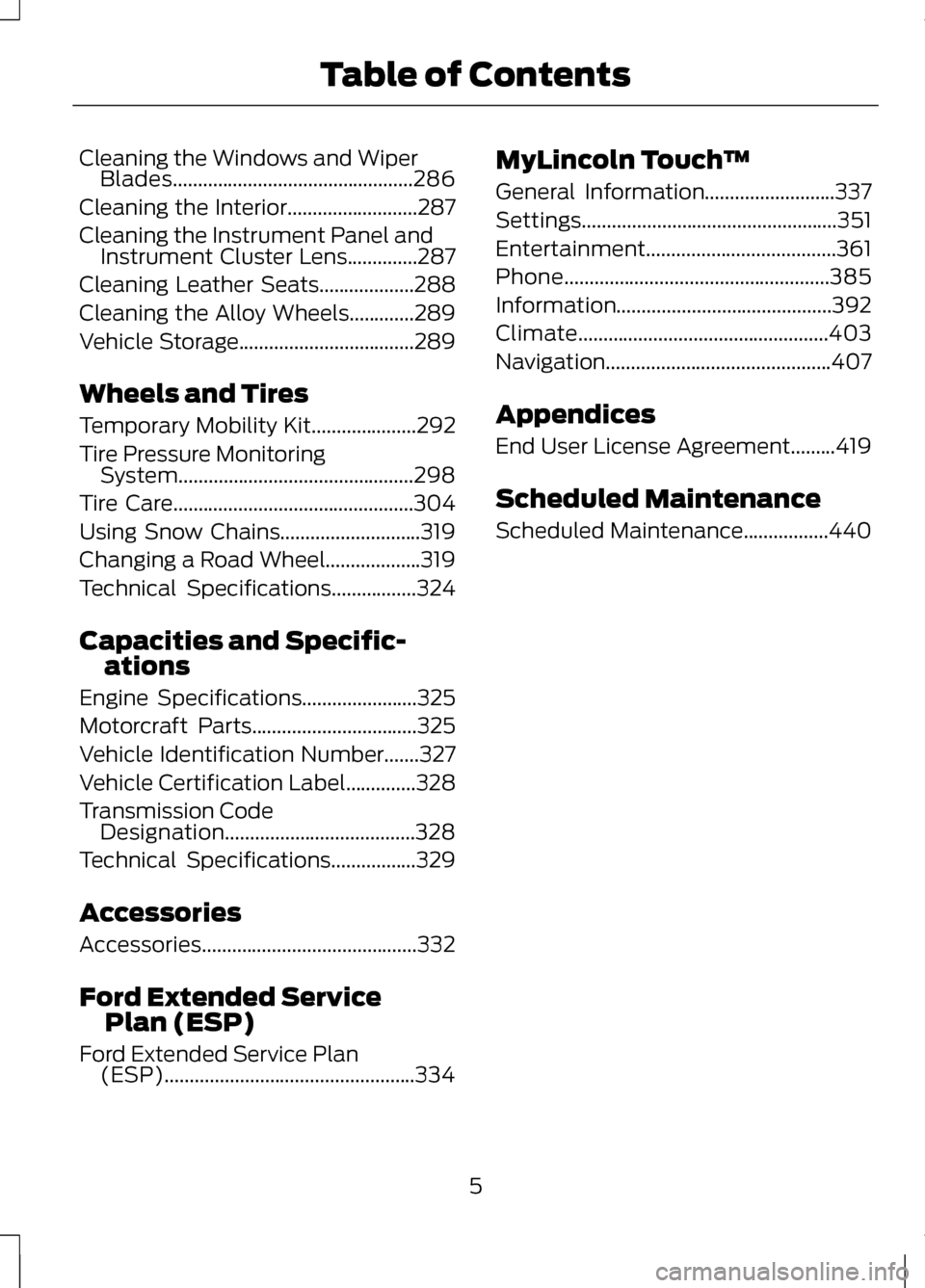
Cleaning the Windows and Wiper
Blades................................................286
Cleaning the Interior
..........................287
Cleaning the Instrument Panel and Instrument Cluster Lens..............287
Cleaning Leather Seats...................288
Cleaning the Alloy Wheels.............289
Vehicle Storage
...................................289
Wheels and Tires
Temporary Mobility Kit.....................292
Tire Pressure Monitoring System...............................................298
Tire Care
................................................304
Using Snow Chains............................319
Changing a Road Wheel
...................319
Technical Specifications
.................324
Capacities and Specific- ations
Engine Specifications
.......................325
Motorcraft Parts.................................325
Vehicle Identification Number
.......327
Vehicle Certification Label..............328
Transmission Code Designation......................................328
Technical Specifications
.................329
Accessories
Accessories...........................................332
Ford Extended Service Plan (ESP)
Ford Extended Service Plan (ESP)..................................................334 MyLincoln Touch
™
General Information
..........................337
Settings...................................................351
Entertainment......................................361
Phone.....................................................385
Information...........................................392
Climate..................................................403
Navigation.............................................407
Appendices
End User License Agreement.........419
Scheduled Maintenance
Scheduled Maintenance
.................440
5
Table of Contents
Page 16 of 474
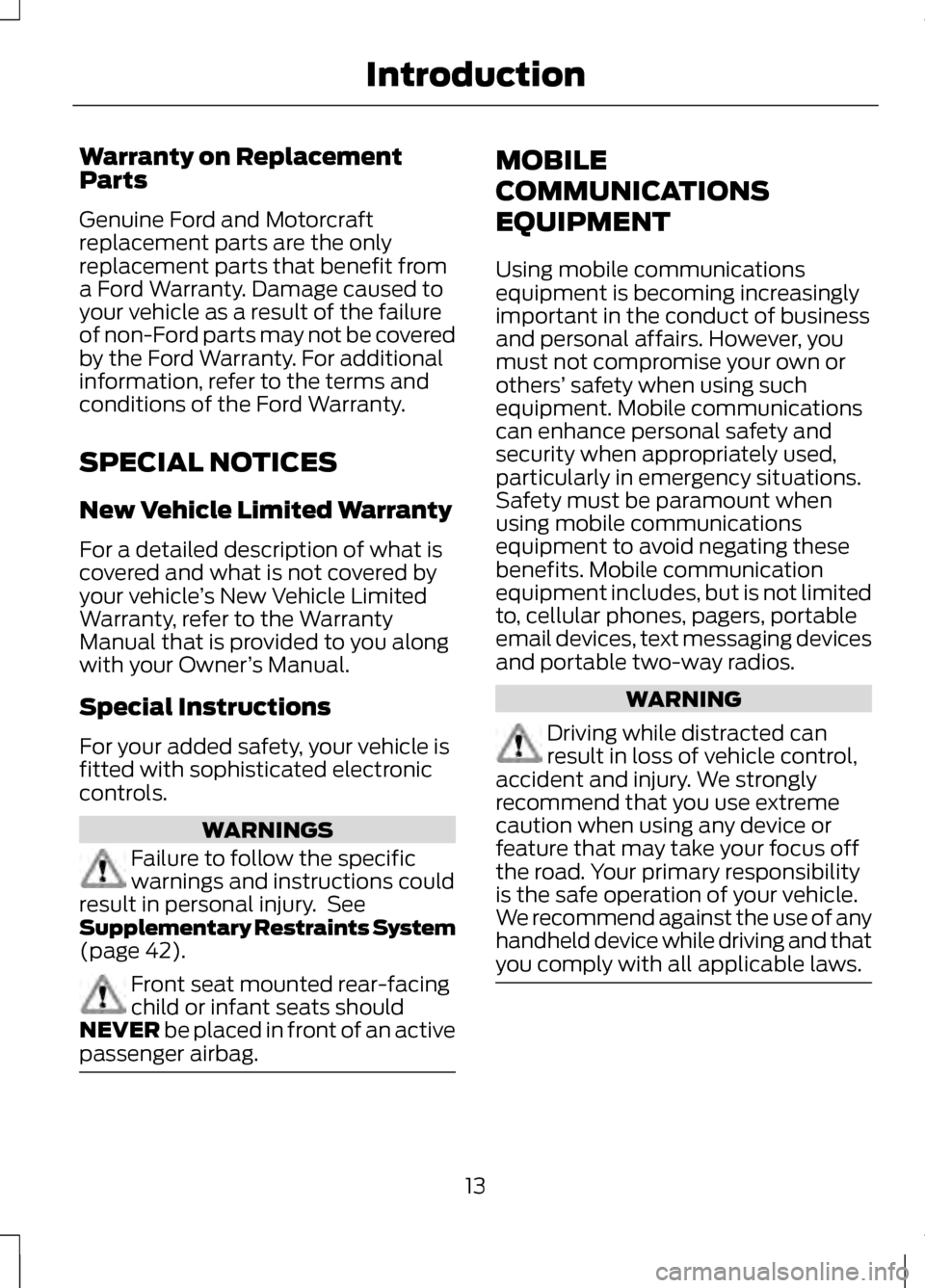
Warranty on Replacement
Parts
Genuine Ford and Motorcraft
replacement parts are the only
replacement parts that benefit from
a Ford Warranty. Damage caused to
your vehicle as a result of the failure
of non-Ford parts may not be covered
by the Ford Warranty. For additional
information, refer to the terms and
conditions of the Ford Warranty.
SPECIAL NOTICES
New Vehicle Limited Warranty
For a detailed description of what is
covered and what is not covered by
your vehicle
’s New Vehicle Limited
Warranty, refer to the Warranty
Manual that is provided to you along
with your Owner ’s Manual.
Special Instructions
For your added safety, your vehicle is
fitted with sophisticated electronic
controls. WARNINGS
Failure to follow the specific
warnings and instructions could
result in personal injury. See
Supplementary Restraints System
(page 42). Front seat mounted rear-facing
child or infant seats should
NEVER
be placed in front of an active
passenger airbag. MOBILE
COMMUNICATIONS
EQUIPMENT
Using mobile communications
equipment is becoming increasingly
important in the conduct of business
and personal affairs. However, you
must not compromise your own or
others’
safety when using such
equipment. Mobile communications
can enhance personal safety and
security when appropriately used,
particularly in emergency situations.
Safety must be paramount when
using mobile communications
equipment to avoid negating these
benefits. Mobile communication
equipment includes, but is not limited
to, cellular phones, pagers, portable
email devices, text messaging devices
and portable two-way radios. WARNING
Driving while distracted can
result in loss of vehicle control,
accident and injury. We strongly
recommend that you use extreme
caution when using any device or
feature that may take your focus off
the road. Your primary responsibility
is the safe operation of your vehicle.
We recommend against the use of any
handheld device while driving and that
you comply with all applicable laws. 13
Introduction
Page 18 of 474
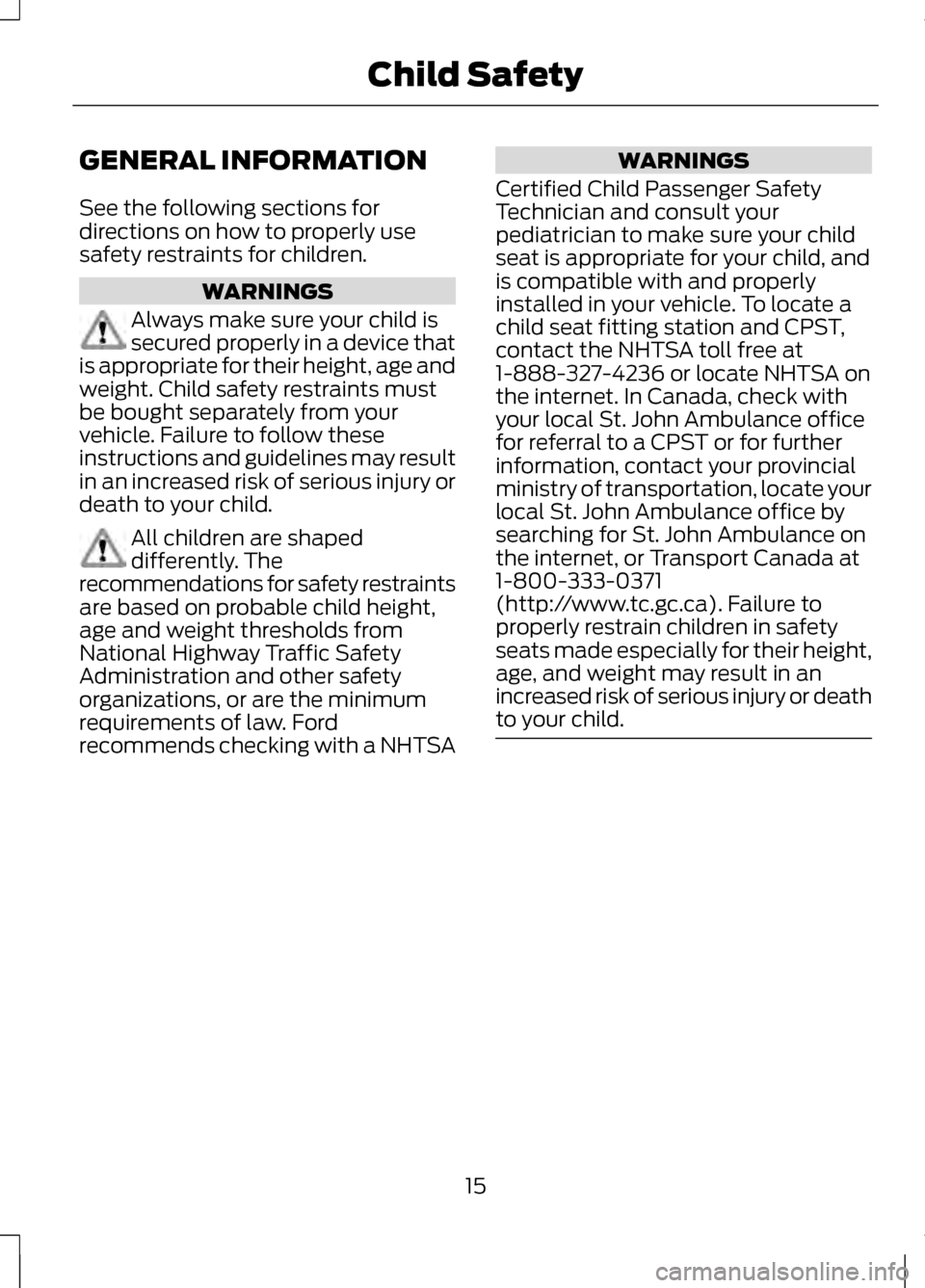
GENERAL INFORMATION
See the following sections for
directions on how to properly use
safety restraints for children.
WARNINGS
Always make sure your child is
secured properly in a device that
is appropriate for their height, age and
weight. Child safety restraints must
be bought separately from your
vehicle. Failure to follow these
instructions and guidelines may result
in an increased risk of serious injury or
death to your child. All children are shaped
differently. The
recommendations for safety restraints
are based on probable child height,
age and weight thresholds from
National Highway Traffic Safety
Administration and other safety
organizations, or are the minimum
requirements of law. Ford
recommends checking with a NHTSA WARNINGS
Certified Child Passenger Safety
Technician and consult your
pediatrician to make sure your child
seat is appropriate for your child, and
is compatible with and properly
installed in your vehicle. To locate a
child seat fitting station and CPST,
contact the NHTSA toll free at
1-888-327-4236 or locate NHTSA on
the internet. In Canada, check with
your local St. John Ambulance office
for referral to a CPST or for further
information, contact your provincial
ministry of transportation, locate your
local St. John Ambulance office by
searching for St. John Ambulance on
the internet, or Transport Canada at
1-800-333-0371
(http://www.tc.gc.ca). Failure to
properly restrain children in safety
seats made especially for their height,
age, and weight may result in an
increased risk of serious injury or death
to your child. 15
Child Safety
Page 20 of 474

•
You are required by law to properly
use safety seats for infants and
toddlers in the United States and
Canada.
• Many states and provinces require
that small children use approved
booster seats until they reach age
eight, a height of 4 feet 9 inches
(1.45 meters) tall, or 80 pounds
(36 kilograms). Check your local
and state or provincial laws for
specific requirements about the
safety of children in your vehicle.
• When possible, always properly
restrain children twelve years of
age and under in a rear seating
position of your vehicle. Accident
statistics suggest that children are
safer when properly restrained in
the rear seating positions than in
a front seating position. See Front
Passenger Sensing System
(page 45).
CHILD SEAT POSITIONING WARNINGS
Airbags can kill or injure a child
in a child seat. NEVER place a
rear-facing child seat in front of an
active airbag. If you must use a
forward-facing child seat in the front
seat, move your vehicle seat all the
way back. When possible, all children
age 12 and under should be properly
restrained in a rear seating position. If
all children cannot be seated and
restrained properly in a rear seating
position, properly restrain the largest
child in the front seat. WARNINGS
Always carefully follow the
instructions and warnings
provided by the manufacturer of any
child restraint to determine if the
restraint device is appropriate for your
child's size, height, weight, or age.
Follow the child restraint
manufacturer's instructions and
warnings provided for installation and
use in conjunction with the
instructions and warnings provided by
your vehicle manufacturer. A safety
seat that is improperly installed or
utilized, is inappropriate for your
child's height, age, or weight or does
not properly fit the child may increase
the risk of serious injury or death. Never let a passenger hold a
child on his or her lap while your
vehicle is moving. The passenger
cannot protect the child from injury in
a collision, which may result in serious
injury or death. Never use pillows, books, or
towels to boost a child. They can
slide around and increase the
likelihood of injury or death in a
collision. Always restrain an unoccupied
child seat or booster seat. These
objects may become projectiles in a
collision or sudden stop, which may
increase the risk of serious injury.
17
Child Safety
Page 21 of 474

WARNINGS
Never place, or allow a child to
place, the shoulder belt under a
child's arm or behind the back
because it reduces the protection for
the upper part of the body and may WARNINGS
increase the risk of injury or death in a
collision. Do not leave children or pets
unattended in your vehicle.
Use any attachment method as indicated below by X
Child
Weight
Restraint
Type Safety
belt only
Safety
belt and LATCH(lower
anchors and top tether
anchor)
Safety
belt and
top tether anchor
LATCH
(lower
anchors only)
LATCH
(lower
anchors and top tether
anchor)
X
X
Up to 48
lb (21 kg)
Rear
facing
child seat
X
X
X
Up to 48
lb (21 kg)
Forward
facing
child seat
X
X
Over 48
lb (21 kg)
Forward
facing
child seat
Note: The child seat must rest tightly
against your vehicle seat. It may be
necessary to lift or remove the head
restraint. See Seats (page 131). BOOSTER SEATS WARNING
Never place, or allow a child to
place, the shoulder belt under a
child's arm or behind the back
because it reduces the protection for
the upper part of the body and may
increase the risk of injury or death in a
collision. 18
Child Safety
Page 22 of 474
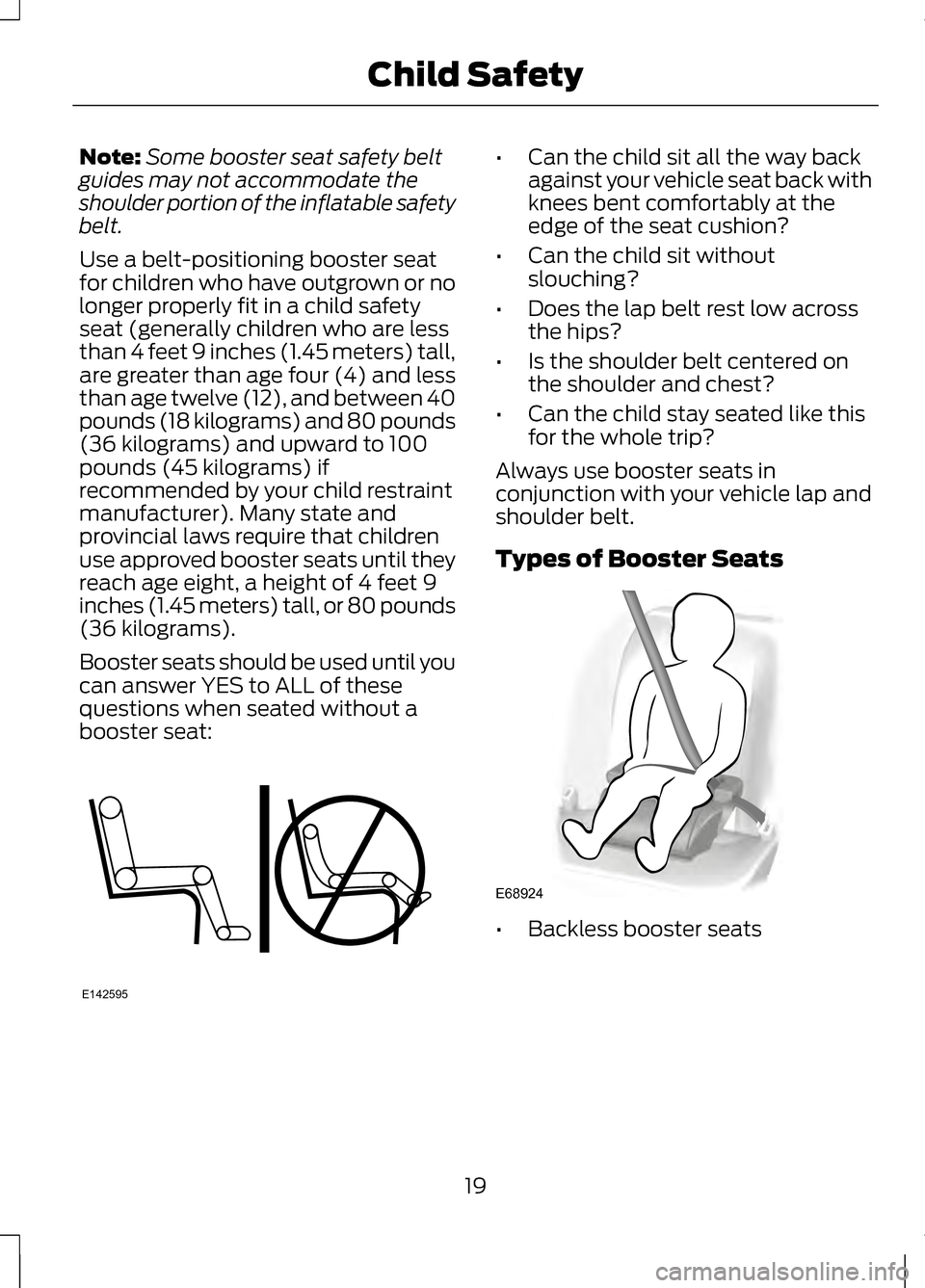
Note:
Some booster seat safety belt
guides may not accommodate the
shoulder portion of the inflatable safety
belt.
Use a belt-positioning booster seat
for children who have outgrown or no
longer properly fit in a child safety
seat (generally children who are less
than 4 feet 9 inches (1.45 meters) tall,
are greater than age four (4) and less
than age twelve (12), and between 40
pounds (18 kilograms) and 80 pounds
(36 kilograms) and upward to 100
pounds (45 kilograms) if
recommended by your child restraint
manufacturer). Many state and
provincial laws require that children
use approved booster seats until they
reach age eight, a height of 4 feet 9
inches (1.45 meters) tall, or 80 pounds
(36 kilograms).
Booster seats should be used until you
can answer YES to ALL of these
questions when seated without a
booster seat: •
Can the child sit all the way back
against your vehicle seat back with
knees bent comfortably at the
edge of the seat cushion?
• Can the child sit without
slouching?
• Does the lap belt rest low across
the hips?
• Is the shoulder belt centered on
the shoulder and chest?
• Can the child stay seated like this
for the whole trip?
Always use booster seats in
conjunction with your vehicle lap and
shoulder belt.
Types of Booster Seats •
Backless booster seats
19
Child SafetyE142595 E68924
Page 23 of 474
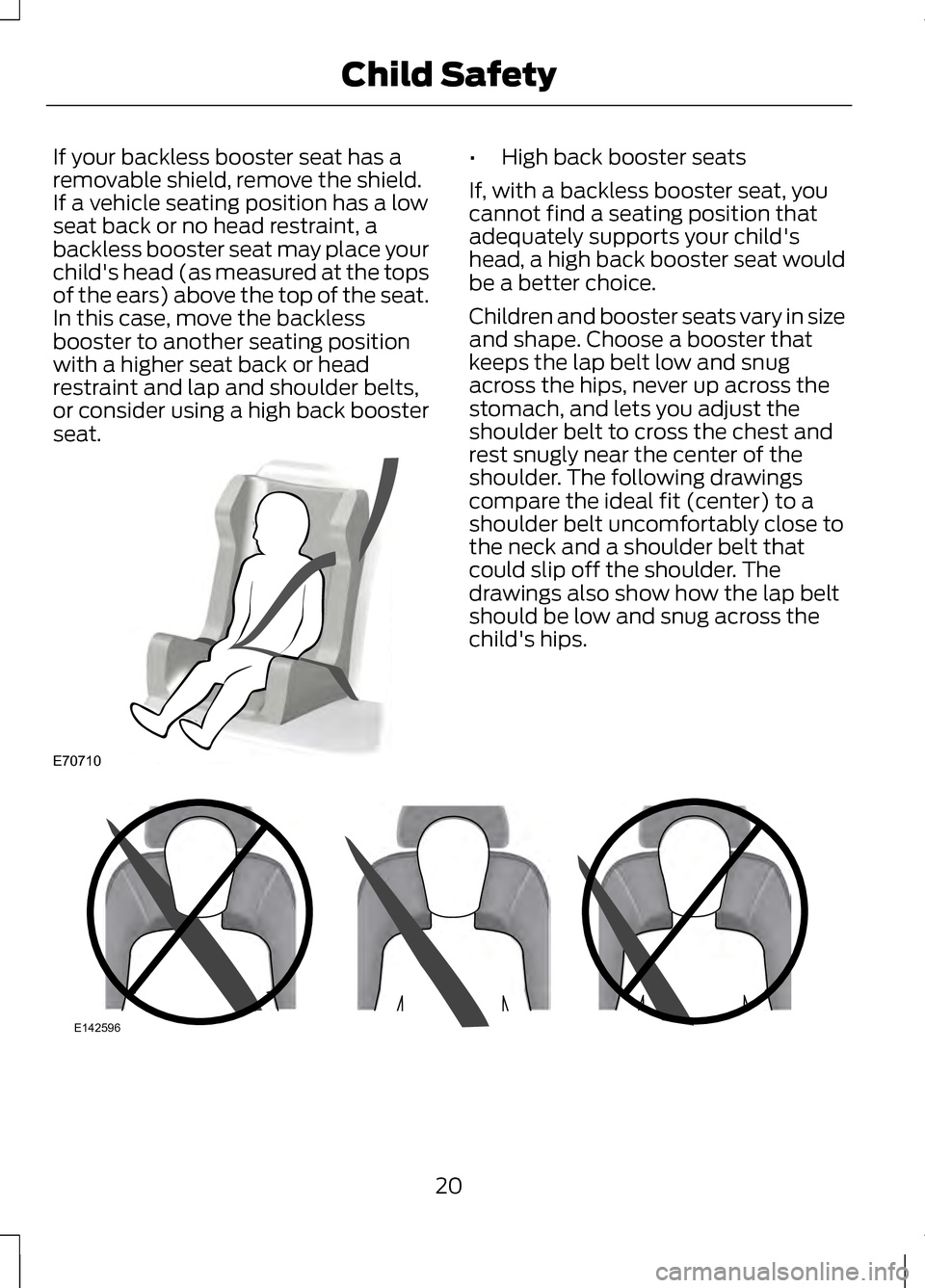
If your backless booster seat has a
removable shield, remove the shield.
If a vehicle seating position has a low
seat back or no head restraint, a
backless booster seat may place your
child's head (as measured at the tops
of the ears) above the top of the seat.
In this case, move the backless
booster to another seating position
with a higher seat back or head
restraint and lap and shoulder belts,
or consider using a high back booster
seat. •
High back booster seats
If, with a backless booster seat, you
cannot find a seating position that
adequately supports your child's
head, a high back booster seat would
be a better choice.
Children and booster seats vary in size
and shape. Choose a booster that
keeps the lap belt low and snug
across the hips, never up across the
stomach, and lets you adjust the
shoulder belt to cross the chest and
rest snugly near the center of the
shoulder. The following drawings
compare the ideal fit (center) to a
shoulder belt uncomfortably close to
the neck and a shoulder belt that
could slip off the shoulder. The
drawings also show how the lap belt
should be low and snug across the
child's hips. 20
Child SafetyE70710 E142596
Page 24 of 474

If the booster seat slides on your
vehicle seat, placing a rubberized
mesh sold as shelf or carpet liner
under the booster seat may improve
this condition. Do not introduce any
item thicker than this under the
booster seat. Check with the booster
seat manufacturer's instructions.
INSTALLING CHILD SEATS
Child Seats
Use a child safety seat (sometimes
called an infant carrier, convertible
seat, or toddler seat) for infants,
toddlers, or children weighing 40
pounds (18 kilograms) or less
(generally age four or younger). Using Lap and Shoulder Belts WARNINGS
Airbags can kill or injure a child
in a child seat. NEVER place a
rear-facing child seat in front of an
active airbag. If you must use a
forward-facing child seat in the front
seat, move the seat all the way back. Children 12 and under should be
properly restrained in the rear
seat whenever possible. Depending on where you secure
a child restraint, and depending
on the child restraint design, you may
block access to certain safety belt
buckle assemblies and LATCH lower
anchors, rendering those features
potentially unusable. To avoid risk of
injury, occupants should only use
seating positions where they are able
to be properly restrained. 21
Child SafetyE142597 E142594